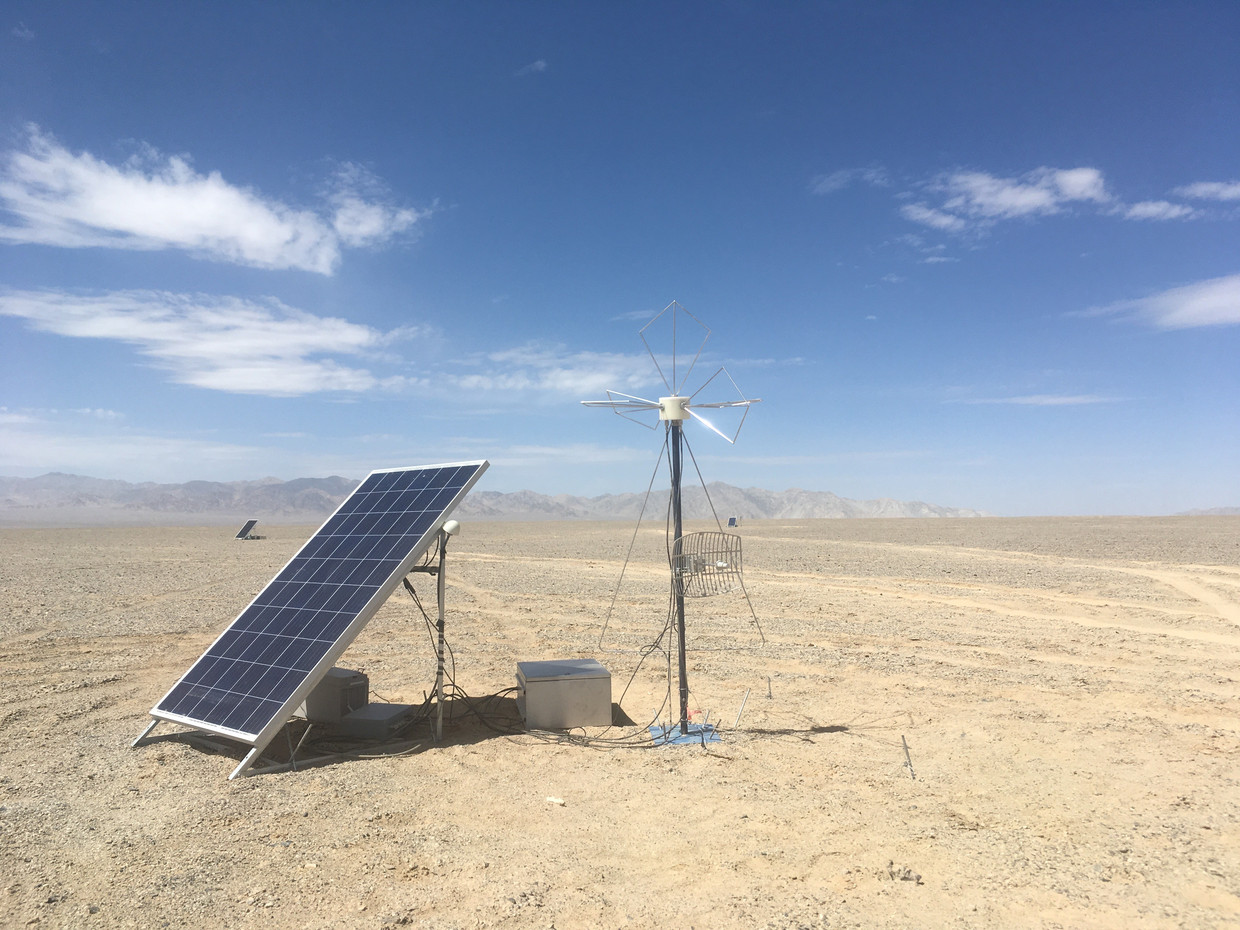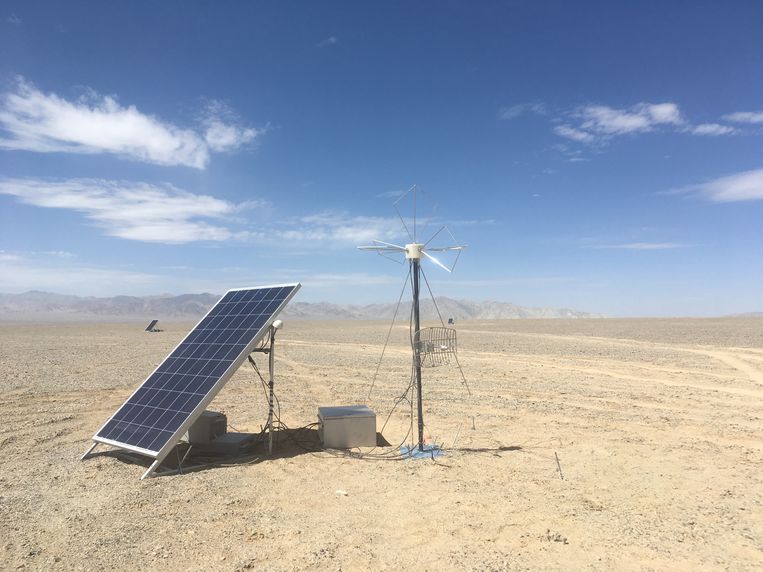
On an inhospitable plateau in western China, on the edge of the Gobi Desert, a strange observatory is under construction. Spread over a huge area, ten thousand wired wireless antennas about five meters high should be here in a few years. Thirteen are now laid down; Project manager Charles Timmermans of Radboud University in Nijmegen expects the first measurement results next spring.
Within ten to fifteen years, Timmermans and his international colleagues (mostly from China and France) hope to solve the mystery of the cosmic “tennis ball particles”. their detector? The high mountains of Tibet.
Electrically charged particles from the universe are constantly raining on the Earth. This so-called cosmic radiation comes from the Sun and from exploding stars in the Milky Way. But every now and then there are extreme examples, with the same amount of energy as a tennis ball being forcefully presented, but then being lumped together into a single subatomic particle. These so-called high-energy cosmic rays were first seen in 1962. The “tennis ball particles” come from outside our Milky Way, but no one knows exactly where they originated and under what energy-rich phenomena.
When such a cosmic force collides with an atomic nucleus in the Earth’s atmosphere, it causes an outburst of complete precipitation of secondary particles. Sensitive instruments on the floor allow you to detect such a shower of particles. But this still does not give you enough information about the exact origin of the original “projectile”. A cosmic ray particle has taken a somewhat twisted path through the universe: due to its electric charge, its orbit is deflected by cosmic magnetic fields.
neutrino
Thus, the radio antennas in China do not catch ultra-high-energy cosmic rays themselves, but rather their accompanying neutrinos, which are expected to be equally rare. Whatever electrically charged “tennis ball particles” are, they are bound to be accompanied by such high-energy neutrinos. Neutrinos are electrically neutral (that’s why they are called that) and therefore are not deflected by magnetic fields. So if you see where they’re coming from, you can trace their origin fairly accurately and then you’ll know right away where the cosmic ray particles are coming from. “Neutrinos with such high energy have not been observed before, but we are convinced that they exist,” Timmermans says.
Current neutrino detectors, such as IceCube in Antarctica and KM3NET in the Mediterranean, cannot “catch” these energy-rich neutrinos. The new observatory in China can do just that: it looks for the radio radiation that is indirectly produced when such a ghostly particle sometimes collides with an atomic nucleus. Hence the name GRAND: Giant Radio Array for Neutrino Detection. Because “ordinary” cosmic ray particles and high-energy gamma photons from the universe also produce radio pulses when they enter Earth’s atmosphere, neutrino hunters pay special attention to signals from mountains on the horizon.
This works through a number of intermediate steps. If a high-energy neutrino source is very low in the sky, it is hidden behind the Tibetan mountain peaks. The neutrino then flies “from the back” into the mountain range. Due to its high energy, it is expected to collide with an atomic nucleus in the rock within a few kilometers. During this collision, secondary particles, which fly from the mountains back into the “foreground”, are completely created by the light of GRAND’s radio antennas. These secondary particles (among other things) are due to electrons and antielectrons, and when they “feel” the Earth’s magnetic field, they emit a small amount of radioactive radiation.
It looks complicated and it is. But the bottom line: If GRAND picked up a radio signal that appeared to come from mountains on the horizon, it must have been indirectly caused by such a highly energetic neutrino. From this it is immediately known from which part of the universe it comes, and in this way you can also track down the mysterious sources of the rare “tennis ball particles” in cosmic rays. At least that is the hope.
new stars
In order to observe the largest possible part of the starry sky, prefer to build such a radio observatory in many places on Earth. So Timmermans and colleagues dream of expanding GRAND with similar antenna fields near the Andes, the Urals, and the Rocky Mountains. In the end, two hundred thousand antennas could be placed, distributed over a common surface five times the size of the Netherlands. Since it is about fairly simple equipment, it should be possible to achieve this with a maximum of 200 million euros, financed by China and Europe.
By the way, GRAND is not the only project that can solve the dilemma of ultra-high-energy cosmic rays. A major upgrade of the Pierre Auger Observatory in Argentina, where astronomers study showers of particles for incoming cosmic rays, will be completed next year. This observatory has previously found indications that the “tennis ball particles” come from galaxies where massive birth waves of new stars are occurring. “The statistics are not convincing enough to claim a discovery, so we need more measurement data to get higher reliability,” says spokeswoman Antonella Castellina of Italy’s INFN Institute.
Meanwhile, Angela Olento of the University of Chicago is working on a space telescope called Poemma that can detect high-energy cosmic rays from Earth’s orbit. Poemma must record the faint flashes of light in the atmosphere that arise when such a powerful particle penetrates. “Puma can monitor large parts of the globe at night, and eventually we can map the origin of the more energy-rich cosmic rays,” says Olinto. If NASA gives the green light to the space telescope, it could be launched around 2030.
Whether the answer will come from GRAND, from the Pierre Auger Observatory or from Poemma is not yet a foregone conclusion. But it won’t be long before it becomes clear which highly energy-rich processes are responsible for the extreme particles. One way or another, astronomers expect the mystery of high-energy cosmic rays to be solved by the mid-1930s at the latest.

“Coffee buff. Twitter fanatic. Tv practitioner. Social media advocate. Pop culture ninja.”











More Stories
Which can cause an increase in nitrogen.
The Central State Real Estate Agency has no additional space to accommodate Ukrainians.
The oystercatcher, the “unlucky national bird,” is increasingly breeding on rooftops.